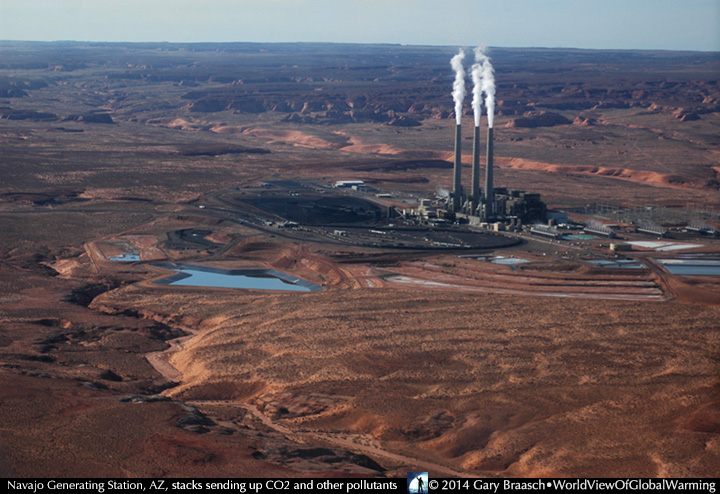Climate Photo of the Week
The President's carbon emission plan: Good news for health as the Clean Air Act continues its positive role in the U.S., but the global warming reductions really needed are still untouched.
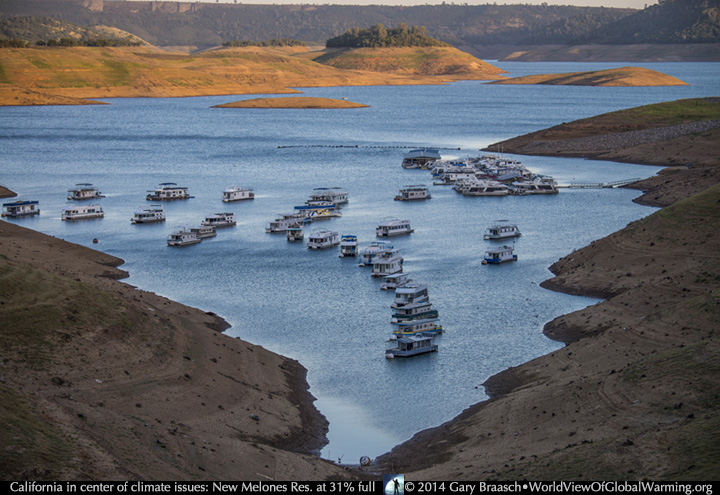
Reaction to the proposed EPA rules limiting carbon pollution from electrical generation (see post below) has been strong and predictable. The EPA, using the authority of the Clean Air Act, will require by 2030 a 30 percent reduction below 2005 levels for existing power plants. Administrator Gina McCarthy introduced the proposal June 2, emphasizing the health effects of coal burning which will be reduced by the plan. Many business interests and some Congress members decried the action, vowing to kill it in court or in Congress. Senate Majority Leader Mitch McConnell called it a "dagger in the heart of the American middle class" that would cripple the U.S. economy.
We have heard these warnings and complaints since the signing of the Clean Air Act in the 1970s -- and they have been wrong. As Tom Zeller wrote in Bloomberg Views, "between 1970 and 2011, aggregate emissions of common air pollutants dropped by 68 percent, even as U.S. gross domestic product grew by 212 percent and vehicle miles traveled increased by 167 percent. The number of private sector jobs increased by 88 percent during that same period." The Economist quoted a study showing that the 1990 strengthening of the Clean Air Act -- which also met with industry howls of doom -- saved about 165,000 deaths from air pollution in 2010 and the economic benefit of all its health savings was more than 30 times the cost of pollution control.
However, if reducing health damage from global warming is the new benefit of using the Clean Air Act, the new power pollution rule is a tiny step forward. Economic and cost factors have already closed some coal power plants and switched others to natural gas, bringing the 30 percent goal already half way closer. Choosing 2005 as a baseline rather than the UN-agreed 1990 beginning point for reductions also makes the EPA's 30 percent reduction actually closer to eight percent (see links in previous post below). This is not a stretch.
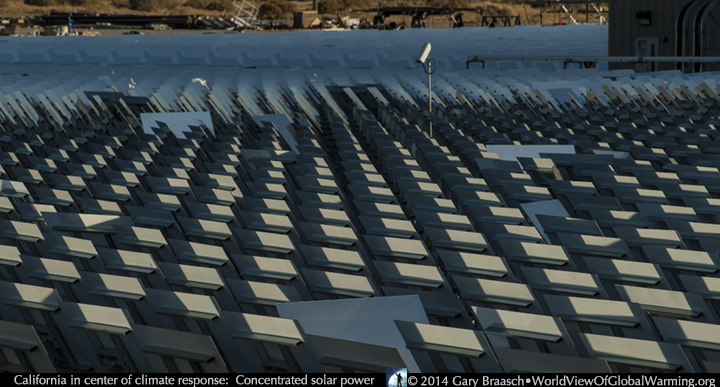
Observers like Ken Ward were quick to point out that not only is turning down some power plant pollution a minor climate improvement, but that focusing on that is a distraction from the much more stringent emissions reductions needed by midcentury to keep the earth from more dangerous warming. The president's avowed energy strategy -- “We need an energy strategy for the future – an all-of-the-above strategy for the 21st century that develops every source of American-made energy.” ( March 15, 2012) -- keeps the nation on fossil fuels like oil and gas, does not rule out export of American coal to be burned elsewhere, and continues huge fossil fuel subsidies which should be focused on much more rapidly developing renewables and efficiency. And the U.S. must be a leader in negotiating with and offering new technologies to other nations of the world for faster emissions control.
Climate Action Tracker, an international group which monitors UN climate pledges, said the U.S. plan comes up short of its promises: “While the proposal is welcome, it is insufficient to meet the US’s pledges of 17 percent reduction of all greenhouse gas emissions by 2020 and is inconsistent with its long-term target of 83 percent below 2005 level by 2050,” said the group. The U.S.’s total 2030 national emissions with the new EPA plan would be around 5 percent above 1990 levels. If there is only little change from the increasing global concentration of CO2 and other greenhouse gases in the air, the tracking group said, average Earth temperature in 2100 will be warmer by 3.7 degrees C -- 6.6 degrees F.
For the first time, EPA regulates carbon emission pollution from electrical power plants. Coal-fired plants become the principal focus of a long-awaited White House move against global warming.
Atmospheric pollution from burning fossil fuels, primarily coal, at electrical generating power plants in the U.S. became the most far-reaching target yet in President Obama's actions to limit U.S. contributions to global warming, with the announcement on June 2 of proposed limits to carbon emissions, primarily CO2. The EPA, using the authority of the Clean Air Act, will require by 2030 a 30 percent reduction below 2005 levels for existing power plants. Administrator Gina McCarthy introduced the proposal, emphasizing the health effects of coal burning which will be reduced by the plan. "Climate change," she said, "fueled by carbon pollution, supercharges risks to our health, our economy, and our way of life." Because power plant CO2 emissions have declined about 13 percent since 2005 due to economic and market forces, the actual reduction from today's levels will be less than 30 percent.
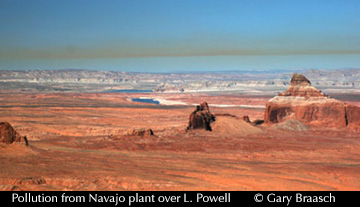 The rules will allow each state to decide how to limit CO2 with a mix of technologies and actions. The heaviest burden will be on the 600 coal-burning plants that belch 75 percent of the carbon dioxide from power generation while making 37 percent of U.S. electricity. During the comment period for the new rules, major environmental groups will launch an aggressive campaign for positive public comments and make climate a political campaign issue, while power companies and their political and media allies will intensify their legislative and legal battle against emissions controls. By a nearly two to one margin, Americans support setting strict limits on carbon dioxide emissions from existing coal-fired plants, according to one recent poll. Many coal-power advocates vilify the President for waging what they call a "war on coal," as if his actions to cut greenhouse emissions are a personal vendetta against coal miners and industry workers. In fact, coal is an extraordinarily dirty fuel, despite its low cost and high power, and has been controlled, even outlawed in some places, for centuries. World-wide, however, coal continues to be a fuel of choice, and partly because of this global emissions of CO2 are rising at record rates. The Clean Air Act already limits the release of sulphur, mercury and other waste gases at power plants. Administrator McCarthy said the new carbon pollution rule will strongly benefit health, and "avoid up to 6,600 premature deaths, up to 150,000 asthma attacks in children, and up to 490,000 missed work or school days—providing up to $93 billion in climate and public health benefits."
The rules will allow each state to decide how to limit CO2 with a mix of technologies and actions. The heaviest burden will be on the 600 coal-burning plants that belch 75 percent of the carbon dioxide from power generation while making 37 percent of U.S. electricity. During the comment period for the new rules, major environmental groups will launch an aggressive campaign for positive public comments and make climate a political campaign issue, while power companies and their political and media allies will intensify their legislative and legal battle against emissions controls. By a nearly two to one margin, Americans support setting strict limits on carbon dioxide emissions from existing coal-fired plants, according to one recent poll. Many coal-power advocates vilify the President for waging what they call a "war on coal," as if his actions to cut greenhouse emissions are a personal vendetta against coal miners and industry workers. In fact, coal is an extraordinarily dirty fuel, despite its low cost and high power, and has been controlled, even outlawed in some places, for centuries. World-wide, however, coal continues to be a fuel of choice, and partly because of this global emissions of CO2 are rising at record rates. The Clean Air Act already limits the release of sulphur, mercury and other waste gases at power plants. Administrator McCarthy said the new carbon pollution rule will strongly benefit health, and "avoid up to 6,600 premature deaths, up to 150,000 asthma attacks in children, and up to 490,000 missed work or school days—providing up to $93 billion in climate and public health benefits."
The U.S. (and the world) should have moved away from its dependence on coal decades ago in a progressive drive for health, clean air and, now, a cooler atmosphere. Like orchestrated research and public information campaigns in "wars" against cancer, crime, harmful drugs and AIDS, reducing coal use is best viewed as a victory for public health and well-being for everyone. Strong programs to retrain and re-engage hard-working coal employees and redirect their power company employers toward clean electrical generation and conservation must be part of our long-range plan to further reduce fossil fuel climate pollution. The President's climate action plan seeks to reduce greenhouse emissions from all sources, including power, vehicles and industry by 17 percent below 2005 levels by 2020 and he is on record at the UN climate talks pledging an 83 percent cut by mid-century. At the same time, creating disagreements with clean energy and environmental leaders, the President continues to strongly advocate for more natural gas production -- also a carbon-polluting fuel that will have to be greatly reduced to reach the levels that climate change action requires. And by choosing the high-emissions year of 2005 for the baseline of U.S. action, the plan sidesteps the 1990 level used for years in international climate calculations and action pledges -- today's 30 percent goal is less than an 8 percent reduction from 1990 emissions.
For more, see these graphs and our Action pages, and the Coal and Energy General sections of the Climate Change Image Library.
About the photo: Navajo Generating Station is a 2250 megawatt coal-fired power plant located on the Navajo Indian Reservation, near Page, Arizona, and is the largest in the west. The plant burns about 8 million tons of low sulfur coal each year. About 520 people work there — 85 percent Navajos -- and it supplies power across the Southwest, but it faces severe requirements from the EPA to cut emissions. The plant is one of the top ten sources of nitrogen oxide emissions in the country. According to the National Parks and Conservation Association (NPCA), this plant degrades air quality at 11 protected national park and wilderness areas and the surrounding Indian reservations . "Its pollution is unhealthy," says the NPCA, "and masks scenic vistas in murky haze during more than 4 months each year at the most impacted national parks, including the Grand Canyon."
"Climate change is happening now... in every part of the United States." National Climate Assessment, most thorough review of how we're being affected, also says progressive change is beginning in how we make and use energy, but much, much more is needed. Please see the illustrated major points of this important review of science, and the news story.
Other recent stories available on World View of Global Warming
A lone scientist reveals the meaning of a melting Arctic Ocean: “You don’t have to care about Arctic seabirds or pack ice,” George Divoky told World View of Global Warming, because the Arctic is not the only place where climate change is causing problems. “Species are struggling to deal with it,” he says, “and we are going to be in the same situation.” Please see story and portfolio here.
In the Pacific Northwest, the oyster industry, with an $84 million yearly value and 3,000 employees, is already seeing and reacting to the effects of unhealthy ocean water.
Story and photos here.
Locations documented by Gary Braasch in World View of Global Warming, 1999-2012
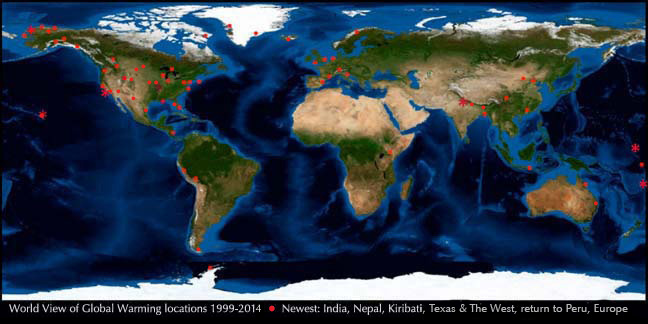
COPYRIGHT NOTICE:
Photography and text Copyright © 2005 - 2017 (and before) Gary Braasch All rights reserved. Use of photographs in any manner without permission is prohibited by US copyright law. Photography is available for license to publications and other uses. Please contact requestinformation@worldviewofglobalwarming.org. View more of Gary Braasch's photography here.



